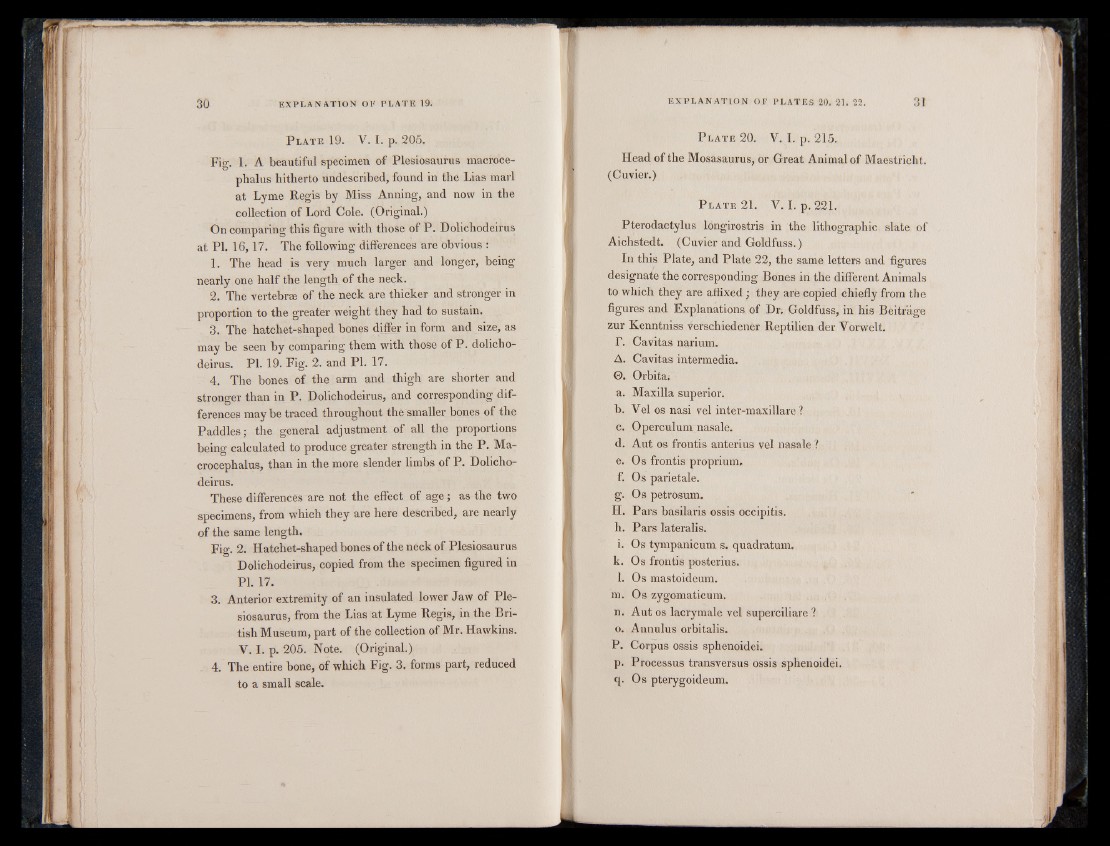
P late 19. V. I. p. 205.
Fig. 1. A beautiful specimen of Plesiosaurus macroce-
phalus hitherto undescribed, found in the Lias marl
at Lyme Regis by Miss Anning, and now in the
collection of Lord Cole. (Original.)
On comparing this figure with those of P. Dolichodeirus
at PI. 16,17. The following differences are obvious :
1. The head is very much larger and longer, being
nearly one half the length of the neck.
2. The vertebrae of the neck are thicker and stronger in
proportion to the greater weight they had to sustain.
3. The hatchet-shaped bones differ in form and size, as
may be seen by comparing them with those of P. dolichodeirus.
PI. 19. Fig. 2. and PI. 17.
4. The bones of the arm and thigh are shorter and
stronger than in P. Dolichodeirus, and corresponding differences
may be traced throughout the smaller bones of the
Paddles; the general adjustment of all the proportions
being calculated to produce greater strength in the P. Ma-
crocephalus, than in the more slender limbs of P. Dolichodeirus.
These differences are not the effect of age; as the two
specimens, from which they are here described, are nearly
of the same length.
Fig. 2. Hatchet-shaped bones of the neck of Plesiosaurus
Dolichodeirus, copied from the specimen figured in
PI. 17.
3. Anterior extremity of an insulated lower Jaw of Plesiosaurus,
from the Lias at Lyme Regis, in the British
Museum, part of the collection of Mr. Hawkins.
V. I. p. 205. Note. (Original.)
4. The entire bone, of which Fig. 3. forms part, reduced
to a small scale.
P late 20. V. I. p. 215.
Head of the Mosasaurus, or Great Animal of Maestricht.
(Cuvier.)
P late 21. V. I. p. 221.
Pterodactylus longirostris in the lithographic slate of
Aichstedt. (Cuvier and Goldfuss.)
In this Plate, and Plate 22, the same letters and figures
designate the corresponding Bones in the different Animals
to which they are affixed ; they are copied chiefly from the
figures and Explanations of Dr. Goldfuss, in his Beiträge
zur Kenntniss verschiedener Reptilien der Vorwelt.
T. Cavitas narium.
A. Cavitas intermedia.
©. Orbita.
a. Maxilla superior.
b. Vel os nasi vel inter-maxillare ?
c. Operculum nasale.
d. Aut os frontis anterius vel nasale ?
e. Os frontis proprium,
f. Os parietale.
g. Os petrosum.
H. Pars basilaris ossis occipitis.
h. Pars lateralis.
i. Os tympanicum s. quadratum.
k. Os frontis posterius.
1. Os mastoideum.
m. Os zygomaticum.
n. Aut os lacrymale vel superciliare ?
o. Annulus orbitalis.
P. Corpus ossis sphenoidei.
p. Processus transversus ossis sphenoidei.
q. Os pterygoideum.